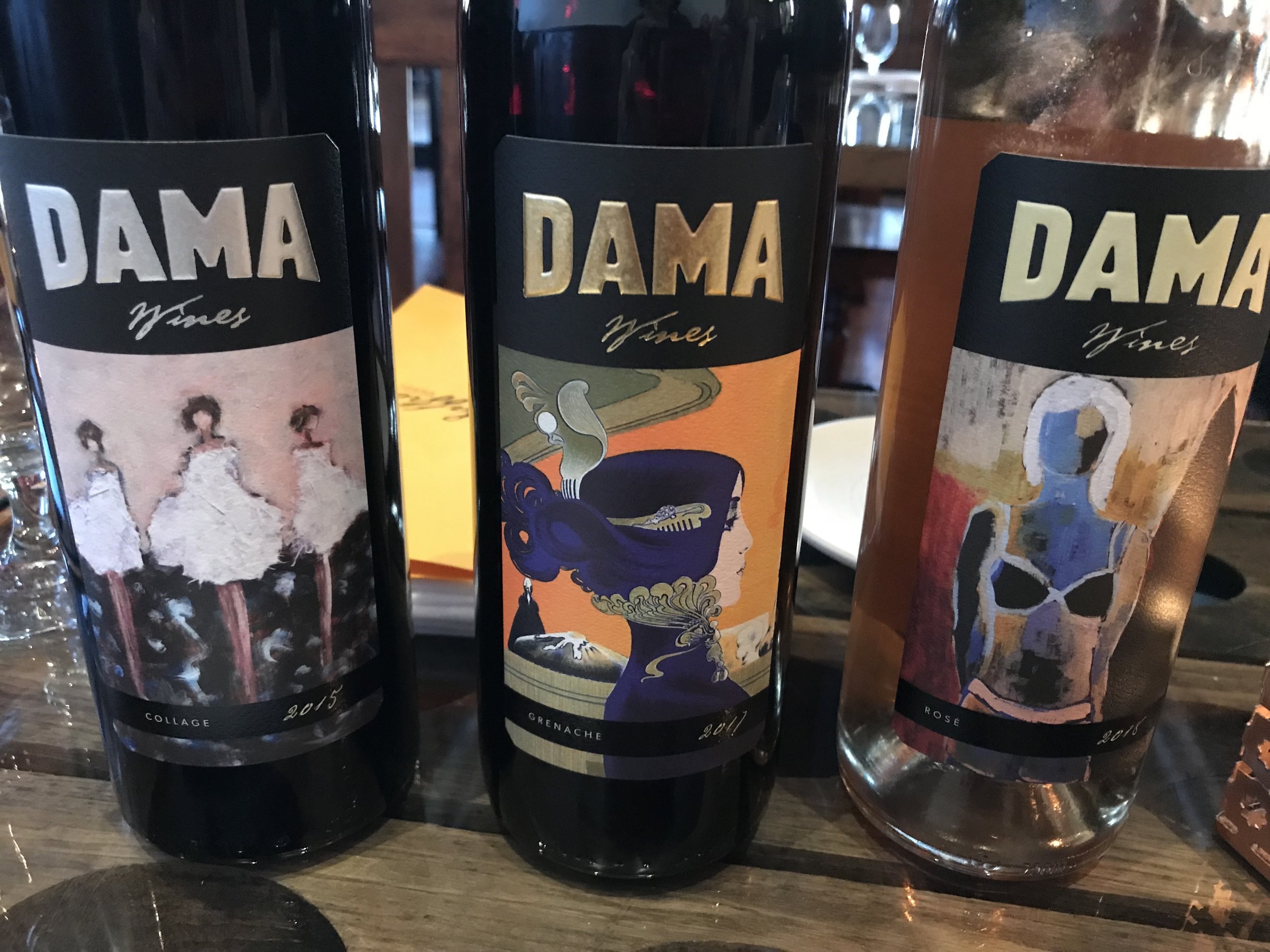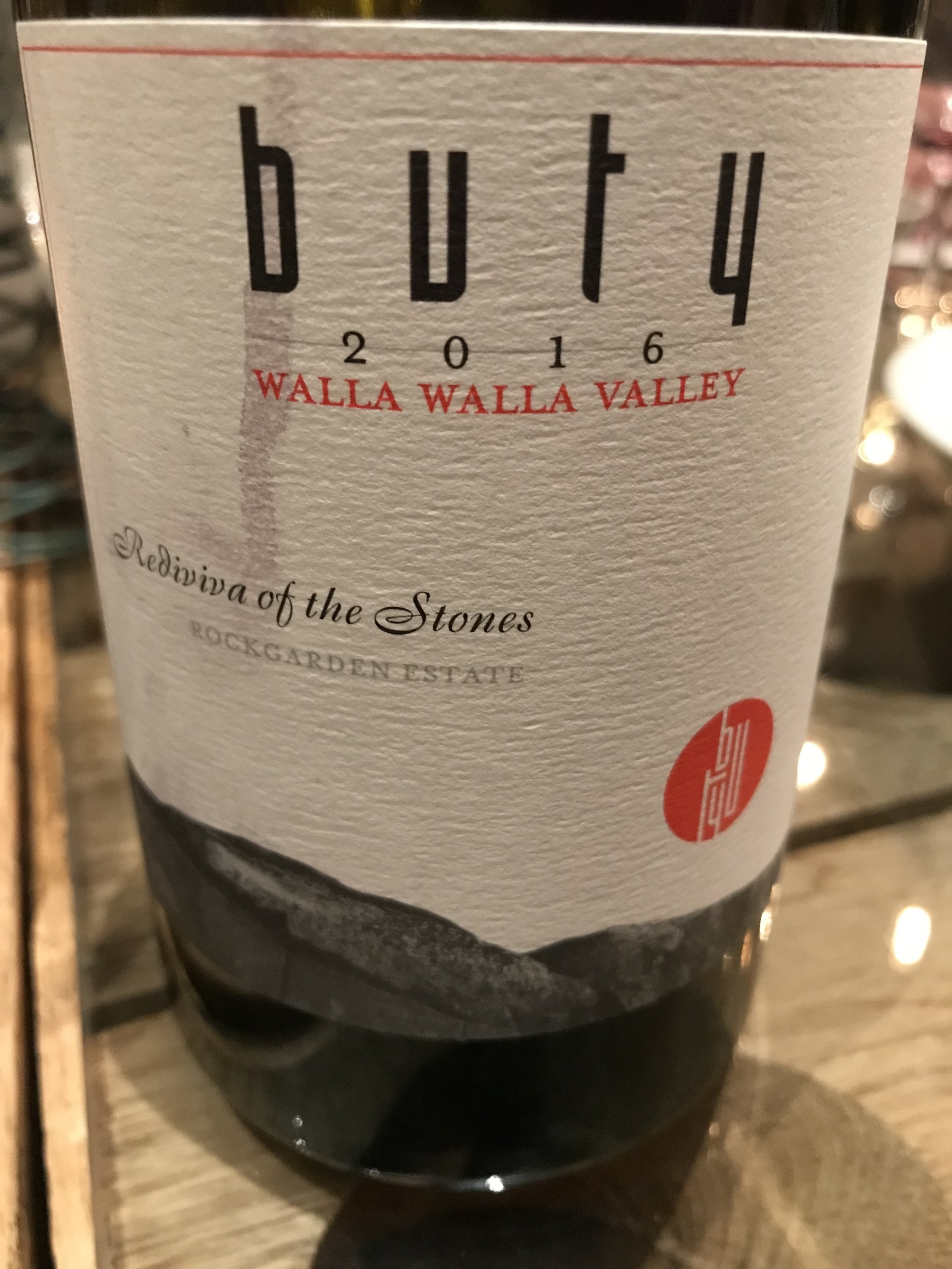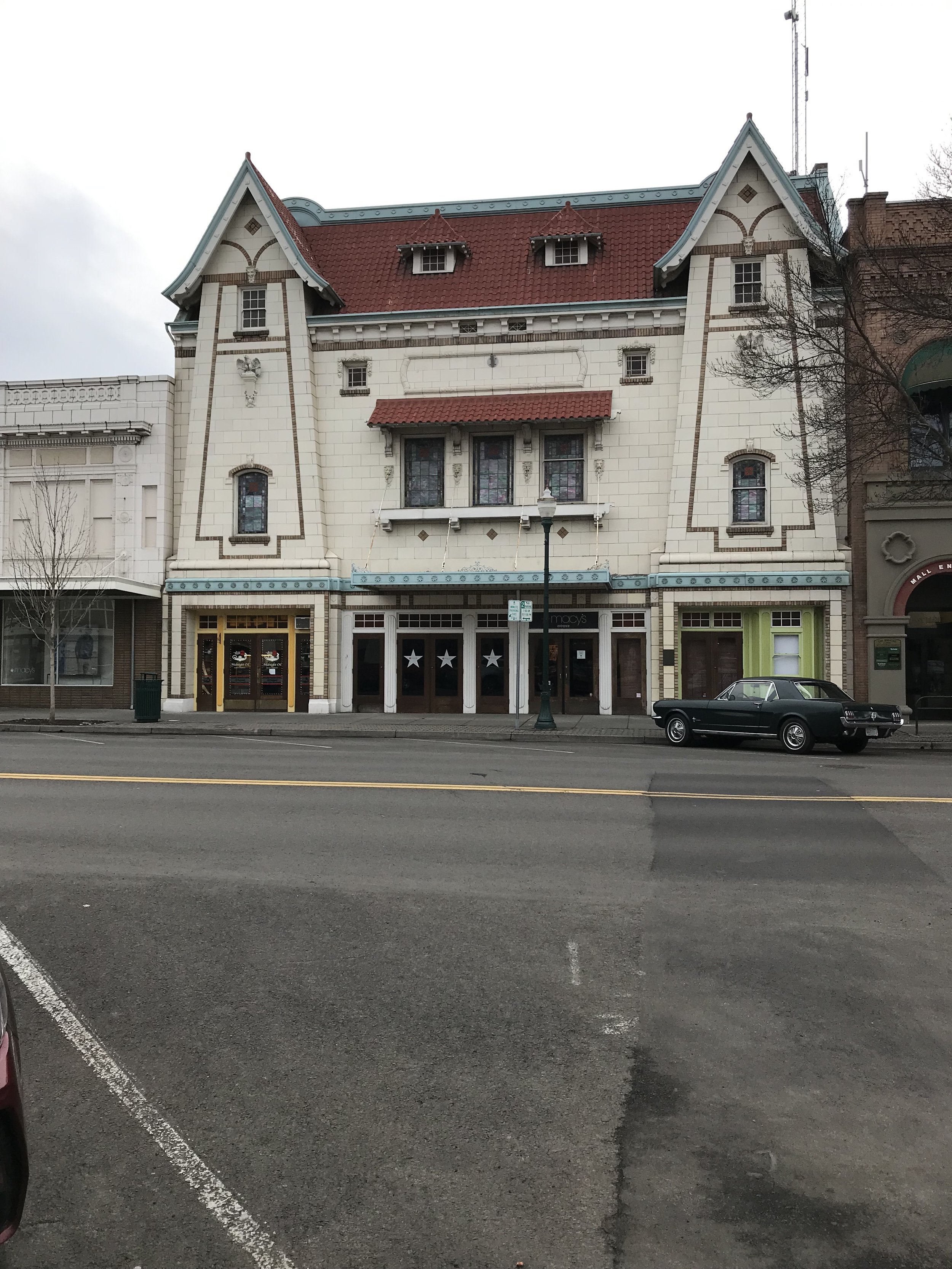Field Trips: Washington Wine Country
The geology of the Pacific Northwest tells its story with Washington wine
lunchtime at Cadaretta Glass House in Walla Walla
All photos by Amanda Schuster
“Plant a flag and commit to a place,” says winemaker Co Dinn of Co Dinn Cellars in Yakima Valley, WA. “Be where the grapes are.” When I recently traveled through Washington wine country, I noticed that is precisely what has been accomplished by the state’s wine producers. With few exception, most Washington wineries are territorial, much in the same way as producers in Europe’s DOCs, preferring to showcase the characteristics of a single viticultural area or small group of adjacent AVAs as a statement of quality.
Representing a particular region gives the wines great distinction. There are 14 AVAs in Washington (with 6 more under petition), and despite being somewhat close to one another, their landscapes and growing conditions, ranging from 100 feet above sea level to over 1000 depending, could not be more diverse.
A few quick facts:
towering rock formation in the Ferguson Vineyard in the Sevein Vineyard Development, adjacent to Seven Hills
It’s all about the diurnal shift (two words uttered in WA wine country as often as “latte please”), which means day to night temperature fluctuations of upwards of 40 degrees thanks to the cooling effects of the Cascade, Rocky and Blue Mountain ranges, allowing grapes to benefit from warm sunlight and cool evenings, which preserves acidity and benefits overall flavor and tannic structure.
The industry is relatively young, with the oldest wineries founded in the 1970s and early 80s, but a large number in the 1990s and later. Thank Walter Clore. In the 1960s, the pioneering viticulturalist, considered the father of WA wine, worked with Washington State University’s Irrigated Agriculture Research Extension Center in Prosser, WA to identify which grape varietals would be best suited for the various conditions around the state.
There are now some 70 grape varieties grown across the regions.
Despite being situated relatively near cloudy and rainy Seattle, the majority of AVAs see 16 hours daily average of sunlight, which is one more than California.
The soils, created from an ancient sea bed, are mostly sand based (loess over Missoula flood slackwater deposits, basalt, clay, silt, loam, sandy loam, etc.). Sandy soils mean the area has never suffered from Phylloxera since the pesky, destructive mites can’t survive the elements, so no vine grafting is necessary. Most vines are original plantings.
Water sources are mainly runoff from the nearby Cascades, Rockies and Blue Mountains, feeding into the Columbia Basin and Columbia River. Naturally occurring underground aquifers run through the various levels of basalt. Wineries also use high tech irrigation systems, mainly drip irrigation, when needed.
One of the earliest varieties to be planted was cabernet sauvignon, and throughout the land, this is the grape that reigns supreme. It’s Washington’s thing, like pinot noir is to Oregon (most Washington wineries let it be that state’s thing, and there is precious few WA pinot).
Walla Walla Valley
Rocks District
One of the most diverse viticultural areas is Walla Walla, established in 1984. It includes the Rocks AVA, which extends into Oregon. It also includes the town of Walla Walla itself, which just over a decade ago was known for its dramatic displays of tumbleweed blowing through the center of town (this is not a metaphor—ask anyone old enough to remember) but is now home to a considerable tourist industry. There are boutique winery storefronts on just about every block, as well as quite a few excellent restaurants showcasing the bounty of the land, and even cocktail bars. Over a scrumptious dinner at Saffron, we met Mary Derby of Dama Wines and Nina Buty of Buty Winery and tasted parts of their outstanding ranges of whites, pinks and reds.
It was here that an infatuation was born.
Rocking out
Like the film title “Snakes On a Plane”, the district known as Rocks is exactly what it sounds like. The wines made from these grapes, mainly Rhône varieties especially syrah, show nearly savory characteristics—think salty, black olives and meaty ham—offset by subtle florals and a deep, earthy, vegetal flavor akin to Cynar. “The voice of the rocks comes through,” said Nina Buty. When I tasted her Redviva of the Stones Rock Garden Estate red I was intrigued by how unusual, but integrated and elegant the flavors were. They struck a chord with me in much the same manner as when I first tasted the deep, mourvedre based wines from Jumilla, Spain when I was in wine school many moons ago. Even the rosé had an astonishing, earthy base note to it unlike any I’d tasted. Besides Buty’s wines, I tasted others made from Rocks-grown grapes—Force Majeure, Dusted Valley, L’Ecole N0. 41 and Trust Cellars. They shared common traits, particularly that element of savoriness, but all were still undeniably rocking out in their own way too.
Sleight of Hand Funkadelic Syrah
A day tour of Walla Walla Valley led by geologist Dr. Kevin Pogue started in the Rocks District and culminated at Seven Hills vineyard, which features high elevated plantings over ancient lava flows with colossal basalt formations wedged into the hillside. The view was breathtaking, if a bit windy to experience (little did I know—more on that later). The grapes, mostly red, either in the cab family or Rhône varietals, respond to the elements rather emotionally, particularly at the start of the growing season, when the diurnal shifts can be the most pronounced. “It’s like you can see the grapes growing by the day,” says viticulturalist Sadie Drury.
“Soil is key here,” says L’Ecole No. 41 winemaker Mike Sharon. “What is even more exciting, however, is that, as a young growing region, we’re still discovering the optimal combination of varietal, soil, aspect, etc., while our vines themselves are gaining in age, so Walla Walla wines in the coming decades will be better and better.”
Even though Walla Walla contains the Rocks district, there is a sharp contrast in the resulting wines from the other parts of the valley—much fruitier, with fewer tannins and less overall edginess. Dr. Pogue insisted the differences in the vineyard sites are much more complicated to explain on a scientific level than simply attributing them to the notion of terroir, since there is such an integral interaction between the vines and the geologic deposits here, and how the grapes respond to them and take nourishment. At no time in my wine experience so far have I been exposed to such a vast demonstration of geologic expression. Never mind everything else that’s going on in the various ecosystems.
Recommended accommodations in Walla Walla:
Marcus Whitman Hotel, a historic, and highly hospitable establishment downtown
Eritage Resort, luxury digs in the heart of wine country with an excellent, upscale attached restaurant
Ryan Johnson at WeatherEye
Red Mountain
Traveling beyond Rocks to Seven Hills in Walla Walla Valley got a tad windy in spots, but the group was instructed to truly brace ourselves for the windy conditions in Red Mountain.
Except that day ended up being almost completely calm, with hardly a cloud in the sky. It’s one of the smallest appellations in the state, with some of the earliest plantings of cab sauv. The conditions, particularly at Kiona vineyards, the region’s founding winery with its prized vineyard known as “Heart of the Hill”, yields small grapes with firm tannins and intense fruit flavors. “But they’re not mossy [in flavor],” explains Kiona winemaker JJ Williams, whose family has made wines there since 1972. For this reason, many wineries look to this particular part of Red Mountain to source grapes for their blends.
Hedges Family Estate, now overseen by brother and sister Christophe Hedges and Sarah Goedhart, is another example of legacy winemaking in Red Mountain. They are among the first to promote biodynamic farming in the area, showcasing classic wine styles with modern techniques and philosophies, preferring to “let the land speak” with the bottlings, particularly their Red Mountain red blend.
stones protecting mourvedre vines from the elements at WeatherEye
While wines from Kiona and Hedges would be considered old school, we were also given a tour of WeatherEye, an experimental, high elevated vineyard site overseen by viticulturalist Ryan Johnson. The slopes are super steep, much like parts of the Rhône, which makes it an ideal spot for planting the holy grenache, syrah and mourvedre GSM trifecta, but also fun stuff like graciano, roussane and viognier. Well, “ideal”, that is, if you’re a grape grower who can withstand the backbreaking work to plant and maintain the vines under such extreme conditions. In one section, it can get so windy that it would overpower the vines, but other factors, particularly sun and rich, well irrigated soils, are too good to pass up, so each vine of mourvedre grown there is outfitted with its own individual hut to shelter it against the wind. Bonkers! Johnson admits he might have overextended in certain areas of WeatherEye, but the efforts could also be a triumph of the what if? scenario.
Horse Heaven Hills
Alexandria Nicole Estate
Between Red Mountain and Yakima Valley is this AVA, one of the newest, established in 2005. With only 25 vineyards and 6 wineries, this small region stands out with its experimental offerings between new wineries like Martinez & Martinez and established ones like Mercer Family. Alexandria Nicole Cellars, owned by Ali (her full first and middle name are the winery’s namesake) and Jarrod Boyle (head winemaker), is known for its sprawling estate featuring a grouping of “tiny houses” for guests—miniaturized, luxury, full service buildings complete with outdoor decks, kitchenettes and some even outfitted with custom wine taps—all around 500 square feet. (So basically, tricked out house versions the size of a typical NYC studio apartment but with outdoor access and way more perks). But Alexandria Nicole goes beyond this schtick with top notch wines made from unexpected varieties such as albariño, roussane, marsanne, tempranillo, primativo and lemberger (a.k.a. Blaufränkisch)—18 different varietals in all. The Boyles purchased the property in the late 1990s with the intention of growing grapes for local wineries, but established their own operation in the early 2000s. “We wanted to make wines with complete control from conception to completion of the wines,” says Ali. Jarrod says growing all these varietals themselves allows certain artistic freedoms. It pays off. It’s not just the winemaking equivalent of throwing spaghetti against the wall, the wines are focused and exciting to taste (especially over banquet style meal in the winery’s basement dining room).
best laid plans at Dubrul
Yakima Valley (cue the wind!)
Mother and daughter winemakers Kathy and Kerry Shiels of Côte Bonneville had the best of educational intentions when they invited the group to its Dubrul Vineyard to sample wines right at their respective vineyard sites and provide an overview. Except, suddenly, the mild, early spring weather went all Wizard of Oz blowy, and we couldn’t even hear each other speak, let alone hold a glass of wine without its contents flying into our faces. There was the wind we were promised, just not where! We finally abandoned the mission (note: Toto could not be reached for comment) and headed to calmer, more civilized digs at the winery’s Sunnyside town tasting room in an old station house.
Here we sampled some of the diverse offerings of the land with the Shiels along with winemaker Co Dinn—all from various wineries across the appellation. The region is famous for its produce in general (Yakima was even covered in New England social studies classes when I was growing up), but the grape cultivation is exceptional. Kerry Shiels says, “It’s all about the root stock.” Wineries like Bonneville and Co Dinn Cellars prefer to stick close to their home bases instead of helicopter parenting their vineyards. Many of the wines we tasted from various producers were in the GSM family, but there was a strong back bone to them, a real point of view, with balance, structure and intriguing layers, from light to full bodied styles. Even the Pacific Northwest winery Owen Roe, known since the early 2000s for its cult releases, saw potential for structured wines made from Yakima Valley fruit. Everything we tasted that day paired exceptionally well with spicy, earthy Mexican fare from local favorite Guerra’s.
Kerry and Kathy Shiels with Co Dinn
Other AVAs visited:
Snipes Mountain, contained within the Yakima valley and where grape farmer Todd Newhouse and his family have been growing on the hilly slopes, appropriately known as Upland Vineyards, for various wineries since the 1960s.
Rattlesnake Hills, where some dozen wineries are producing classic Bordeaux single varietals and blends as well as experimental releases—everything from fun rosés in a can to zinfandel.
Woodinville, just outside of Seattle and home to Chateau Ste. Michelle, considered the WA winery that started it all. It now boasts a state of the art production facility and visitor’s center, including a swank bar and gift shop. It’s also definitely worth a splurge to stay at the luxurious and relaxing Willows Lodge resort and spa.
Wines to try
Walla Walla:
Dama Grenache 2017 ($40), a jammy, yet well structured pick from one of the town’s excellent boutique wineries, and the label is gorgeous too.
L’Ecole No. 41 Walla Walla Valley Estate Syrah 2016, ($36), here this grape is showcased with great depth and richness
Sleight of Hand “The Funkadelic” Syrah 2016 ($60), versatile and velvety, plus one of the coolest wine labels ever (see pic)
Bledsoe Family Winery Elizabeth Chardonnay 2017, (inquire with winery for purchase), very much akin to a white Burgundy Chablis style, with brightness and ripe fruit without excessive oak extraction or flabbiness
Trust Cellars Syrah Walla Walla 2016 ($34), so dark and meaty you’d swear you’re drinking a Côte Rotie
Rocks:
Buty Redviva of the Stones Rockgarden Estate red 2016 and rosé 2018 ($60/$25)—the wines that launched many more sips from this unique district
Dusted Valley Stained Tooth Syrah 2016 ($36), here’s how the power of the Rocks can shine through. 100% syrah grapes in this wine hail from Wahluke Slope in Columbia Valley, giving it a softer feel, with Rocks-grown grapes blended in for depth of flavor.
Force Majeure SJR Syrah 2016, it might be tough to find, but winemaker Todd Alexander really shows his point of view with this release that’s got serious, in-your-face minerality, a slight perfume and silky plum and blackberry fruits
Red Mountain
Hedges Family Estate Cabernet Sauvignon 2015 ($40), biodynamically farmed with fresh cherry, plum and thyme notes, it’s ready to drink now, but highly cellar worthy
Kiona Old Block 2014 red ($75), a great way to taste the legacy of the region
Force Majeure Viognier 2017, (inquire directly with vineyard), refreshing and not too perfumey, great with shellfish
Horse Heaven Hills
Alexandria Nicole Affinity Albariño 2018 ($25), the winery excels with its reds, but to really get a sense of their talents, try this juicy, citrusy sipper
Alexandria Nicole Rosé 2018 ($18), unlike any I’ve tasted, watermellony with a refreshing herbal finish
Mercer Estates Reserve Cabernet Sauvignon 2016 (inquire with winery for pricing), cab sauv is blended with a small percentage of syrah and merlot to bring out its red and dark berry fruit with a hint of pipe tobacco and dark chocolate
Columbia Valley
Two Mountain’s chief resident
Cavatappi Sangiovese 2015 ($13), from Precept wines, who also produce Gruet from New Mexico as well as many labels across WA state, made with grapes grown in Yakima Valley. I dare you to blind taste this with a Chianti Classico and see if you can tell which is which.
Pursued By Bear Blushing Bear Rosé 2018 ($28), actor Kyle MacLachlan grew up in Yakima, and returned to his home state in 2005 to found this wine project. Made with 50% mourvedre, 30% grenache and 20% cinsault—don’t be fooled by the pale pink hue, you can drink this wine while you’re mauling a grilled steak or a burger.
Yakima Valley
Cote Bonneville Syrah 2015 ($65), showcasing how this grape fares in high elevation with cool weather influences in Dubrul Vineyard
Owen Roe Sinister Hand Yakima 2016 red blend ($28), a GSM with some cinsault that’s got some luscious dark fruit and a slight herbal note. I so want to drink this with grilled duck breast and blueberry sauce.
Co Dinn Cellars GSM Red Blend Lonesome Spring Ranch 2014 ($45), grapes for this wine are late ripeners, resulting in a wine with rich blueberry, tangerine rind and some elegant peppery and cocoa notes.
Pacific Rim Riesling Solstice Vineyard, with all of the stone fruit you’d expect from this grape, but also unexpected acidity and earthiness and fairly low residual sugar
Snipe Mountain
Latta Upland Valley Grenache 2015 ($45), the typical jamminess of the grape shows a surprising earthy edge here, and would be perfect served with a slight chill on warm summer evenings
Upland Estates Teunis 2011 ($45), a Bordeaux blend made from grapes grown practically at a vertical angle. It’s full-bodied, yet juicy with balanced earthy notes, herbs and spice.
Rattlesnake Hills
the visitor’s center at Chateau Ste. Michelle
Two Mountain Pinot Gris 2017 ($20), this refreshing white wine has ripe pear and tropical fruit sweetness offset by an unexpected hint of spice.
Two Mountain Rosé 2018 ($18 for bottle, $22 for 3-pack 250mL minis), if you like the filling of strawberry rhubarb pie, this is the pink wine for you, made from cab franc and cab sauv
Portteus Zinfandel 2015 ($26), zin is a grape rarely found in WA wine country, but this is one of the first to give it a go with a pleasing, dry spin that doesn’t feel too alcoholic
Woodinville
Delille Cellars D2 2016 red blend ($45), this is the 25th vintage of this well balanced Bordeaux blend made with merlot, cabernet sauv, cabernet franc, malbec and petit verdot
Domaine Ste. Michelle Brut ($13), though the winery’s cabernet-based reds put them on the WA wine map, this zippy sparkler tastes way more expensive than it is, making it an ideal everyday bubbly
















